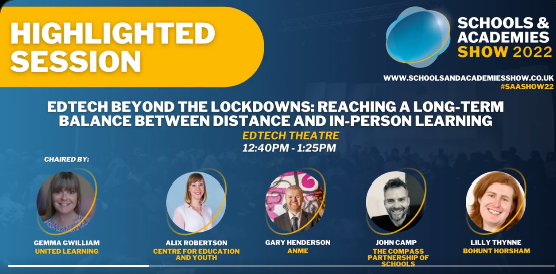Am attending the School and Academies show in London this week including being part of a panel session discussing “EdTech Beyond the Lockdowns: Reaching a Long-Term Balance Between Distance and In-Person Learning”. Firstly, I have my fingers crossed that I can manage to get to London and the event without any of my usual travel mishaps, and if any travel mishaps have to happen the happen after I have finished the panel session.

As always, one of the big benefits to these events is simply the networking side of things and getting to meet and discuss various educational issues with colleagues from schools and colleges from across the UK and beyond. I note that the Association of Network Managers in Education (ANME), of which I am an ambassador, have a stand (D34) at the event, so it is likely I will spend some of my time there catching up with other ANME members. Hopefully, I can get a few more selfies at this event, than I did at Bett earlier in the year.
In terms of the panel session, one of the questions posed relates to the efficacy of EdTech and this has got me thinking. EdTech covers such a broad range of tools, from visualisers to bits of software, AR/VR headsets, the dreaded interactive whiteboard, and many other technologies. In addition, each technology may be used in different ways dependent on the students, the curriculum content being covered, the access to equipment, etc, plus the impact of EdTech will depend on what impact is being sought, the skill level in tech use of the teachers and the students, the organisational culture of the school plus its climate, along with a multitude of other factors. In seeking an analogy, I wonder if seeking to access the efficacy of EdTech is much akin to seeking to assess the efficacy of hand tools such as hammers, screwdrivers, saws, etc. It depends on user skill level, with a skilled tradesperson more likely to get positive outcomes than your average DIY’er. It also depends on purpose, with a hammer used to nail together your shed seen as more positive, than a hammer being mis-used as a weapon of violence. As such seeking the general efficacy of EdTech seems a little difficult, or possibly even a little meaningless.
Maybe we need to change the question and focus on the potential for positive impact. On this front I think there is plenty of evidence of specific technologies being used in schools and colleges to positive effect. From this I think it is also possible to identify some of the features which support technology to have a positive impact in schools, such as appropriate staff training, an open and supportive climate which supports innovation and experimentation, collaboration between staff as to successes and challenges plus students and staff who are engaged in what and how technology is used.
I am looking forward to being part of the School and Academies Show event and to sharing my thoughts, to seeing what exhibitors are there, to networking with peers and hopefully to NOT getting lost, on the wrong train or a similar travel mishap.

